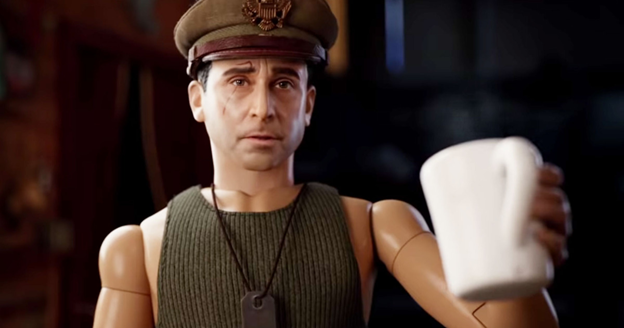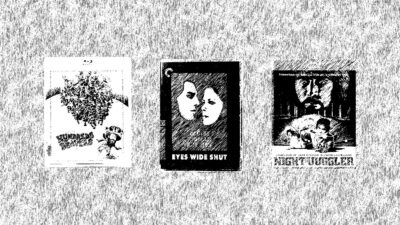WELCOME TO MARWEN is the cinematic equivalent of a gentrified gay bar. Zemeckis has always struck me as a bit of a peabrain (I’m not a fan of his maudlin sentimentality and tendency to reduce an individual to a mouthpiece for a political ideal), but wow, does this blow past any perceived expectations of inferiority. An offensive, demented offering—too incompetent to be Oscar bait, too brutal for kids, and too dumbed-down for adults, not to mention too straight to be queer, WELCOME TO MARWEN is a crowd-pleaser for a crowd that really wasn’t ever there.
The film is based on the true story of Mark Hogancamp, an artist who is the victim of a debilitating assault and loses his memory up until that moment—at which point, he decides to dedicate his time toward photographing the doll-sized world of Marwen to imbue him with purpose and meaning in a vicious world. Said world of Marwen is infested with Nazis, lending to the film’s graphic violence—make no mistake, Zemeckis revels in the stuff here, lingering on bullet-spraying murder and bloody impalements. The fact that the violence occurs mainly to dolls somehow grants Zemeckis MPAA leverage, allowing him to engage in bouts of disturbing carnage without risking an R-rating. Zemeckis indulges in, admittedly, beautiful animated sequences with the glee of a sugar-inundated six-year-old, despite the fact that these sequences do nothing to develop character or advance the narrative. Much of MARWEN is redundant, and much of the live-action material feels merely like a segue toward another “adventurous” animated outing through Marwen.

Here’s to trivializing real mental health disorders!
Steve Carell gives arguably his worst performance to date as Mark, though, admittedly, he’s not given anything to work with besides the equally mediocre Leslie Mann, whose intrinsic bubbleyness is mitigated by the film’s dour protocol. Carell is on visible autopilot here, careening through formulaic script beats with subtlety on par with Zemeckis’ music cues. In one of the film’s unintentionally hilarious moments, a character sieg heils, and is promptly accompanied by a damning horn ensemble. Zemeckis isn’t afraid of cliches, instead he embraces them—using a scrapbook for exposition, developing characters who may as well be named by their defining character trait—eg. HATEFUL or SWEET, and including the most obvious implementation of handheld photography we’ve seen in 2018. Treatment of Mark’s PTSD is, shockingly enough, poorly handled, spitting in the faces of those afflicted with the actual disorder by indulging in visual extravagance instead of paying attention to the character’s internal state.
WELCOME TO MARWEN is also surprisingly inept at developing suspense or forward momentum, with Mark’s impending court date and art show rendered moot by the screenplay, which fancies extended sequences of animated mayhem through Marwen. Zemeckis’ shot selection deliberately belittles Mark—choice shots condescend toward Mark, framing him as nothing but a helpless little lamb. Symbolism is ham-fisted, with the evil witch of Marwen being a stand-in for Mark’s medication, which, in a shocking move, is demonized even though we don’t see once the adverse effects of Mark’s pill-popping habit. In order to identify with the character’s eventual realization that the medication is bringing him down, we need to understand why these drugs are dangerous. Zemeckis doesn’t do this, instead positing that all medication is useless and irrelevant, and that we may all become stronger individuals by abandoning it. Medication has saved countless numbers of lives, and for Zemeckis to discredit that point in one swift stroke is downright irresponsible.

A bit of the old ultraviolence
However, the most problematic aspect of the film, as hinted in the opening of this review, is the film’s regressive attitude toward queerness, and general ignorance of queer issues. Zemeckis conflates queerness with crossdressing in a film that is, in its conception and execution, decidedly heterosexual. Mark only shows interest in women, but the film tries to convince us that this is really a portrait of a man finding his queer identity—not so. In fact, in the film’s closing moments, Zemeckis shamelessly appropriates queer iconography simply in order to add “edge” to a milquetoast portrait of an apparently cishet male. It’s a shocking move, all the more so because you can practically feel Zemeckis and co. patting themselves on the back for being progressive crusaders of social justice. If you’re interested in the true story, and it is a fascinating one despite this film’s bungling of it, check out 2010’s MARWENCOL, the vastly superior documentary on Mark Hogancamp that serves as a legitimate study of trauma and escapism.WELCOME TO MARWEN, on the other hand, is a disgusting picture, mean-spirited and ugly, and we would all do best by promptly forgetting it.















Comments